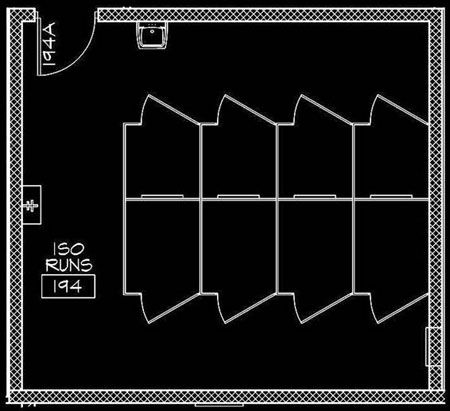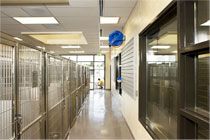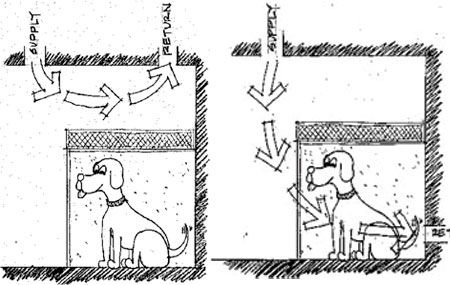Disease and aerosolized muckoh my!
Face it: Some areas of your practice are, well, kinda gross. Let this cleanliness-focused veterinary architect show you better ways to be germ-free.
It can be tough to keep a veterinary practice or other animal facility clean unless it's been designed with biological risk management in mind, according to veterinary architect Heather Lewis, AIA, NCARB, of Animal Arts in Boulder, Colorado. To start, Lewis turns to the four primary modes of disease transmission in animal facilities as detailed by the UC Davis School of Veterinary Medicine:
1. Fomite transmission
2. Environmental transmission
3. Direct contact
4. Aerosol transmission
Bonus mode of disease transmission:
There is a fifth mode of disease transmission. Vector transmission-an example of which would be mosquito borne illness-but we sincerely hope this mode isn't relevant to the inside of your hospital.
Now you can clean up your act with Lewis' recommendations for fighting off the four primary modes of disease transmission ...
Fo-whats?
Many of us focus on aerosol transmission, but it's actually the least likely mode of transmission in your hospital. Fomites-contaminated objects that spread disease-are much more likely to cause a problem. And it's not limited just to inanimate objects, because you and your staff can become fomites via your clothing or hands, Lewis says. To cut down on this, think about these strategies when designing your facility:
> Plan space for conveniently located sinks, glove dispensers and hand sanitizer stations. Keep in mind that hand sanitizers don't kill non-enveloped viruses, so sinks are still important. It's also important to use sanitizers specifically made for animal care facilities. For example-products with phenols in them can be toxic to cats.

In this example the sink is located right next to the door, to make handwashing convenient. Photo courtesy of Animal Arts.
> Make sure your sink's water pressure isn't too high and “splashy.” You'll just wind up with contaminants from the drain on your freshly cleaned hands.
> Provide convenient ways to sterilize equipment and tools. Consider sinks, sterilizing equipment, laundry equipment and dishwashers.
> Ban traditional reusable mops. Seriously, they're petri dishes of never-quite-clean-again grossness after they've been used once. Flat microfiber mop heads, which can be removed easily so a different mop head can be used in each room, are a great alternative to traditional mops, Lewis says. The microfiber heads can then be laundered and reused.
> Provide proper gowning and decontamination areas for staff use when handling contagious animals. Ideally, in a new building there would be a “vestibule” outside of your isolation room, but it could also be an alcove or marked of area on the floor where personal protective equipment is donned.
> Install animal housing that's designed to prevent unnecessary handling of animals.
A toxic environment
You have three main areas to focus on, Lewis says: facility layout, building materials and proper use of water and disinfectants.
Biofilm at 11!
Common sense tells you it's impossible to keep your hospital clean without using cleanable materials. However, even if you use appropriate materials, Lewis says biofilms still develop over time. Biofilms can be abolished with abrasive action, assuming your finishes can withstand this rough treatment.
Layout. Your facility can help or hurt you. Design to avoid environmental contamination by:
> Providing convenient outside access to isolation rooms for treating contagious animals. Be sure to include a small prep area for gowning, gloving and decontamination within isolation areas.
> Placing janitorial areas and supplies near the places they serve.
> Organizing laundry and utility rooms to prevent contamination of clean items. For instance, wards should be cleaned from the dirtiest areas first to the cleaner areas. (That's why drains should be placed at the back of runs.)
Materials. Finishes should be chosen based on how you'll need to clean the space. For rooms that need a real hose-down, finishes will need be hardy, according to Lewis. You'll need:
Think smart when choosing a hose system
Nothing recontaminates freshly cleaned surfaces like dragging a hose around on the floor, Lewis says. Hose equipment should correlate to the size of the room and the effort needed to clean the room properly.
For example, a large room with lots of dog runs might call for a ceiling-mounted hose reel with a clutch to control the speed of the hose when it's retracted. This keeps the hose off the floor and out of the way so the room can be cleaned effectively and quickly. The clutch keeps staff safe from high-velocity attacks by hose.

A ceiling-mounted hose reel system. Photo courtesy of Animal Arts.
> Seamless wall materials, flooring and sanitary cove base
> Rot- and mold-resistant backing
> Appropriate ceiling materials, including sag-resistant tiles and vapor-tight fixtures
> Galvanized doors and frames
> High-performance coatings for exposed metals.
Water. Using H2O to prevent environmental contamination must be done carefully. Use water in areas not properly sealed and designed for water, and you'll wind up with more contaminants growing and accumulating in, on and around those surfaces. And no-higher pressure doesn't mean better cleaning. Blasting muck with high-pressure water can actually aerosolize particles. If you're going to use a pressure system, follow these guidelines:
A solid idea
Lewis knows that dealing with solid waste can be unpleasant. If your hospital has a large number of runs and can justify the expense, a great solution is to design a “poop closet.” This special janitorial area would contain a large flushing rim sink, like those used at nursing homes, an exhaust vent to control odor, and a hose and floor drain for cleanup.

An example of a "poop closet." Photo courtesy of Animal Arts.
> Pick a medium-pressure system with a history of use in animal facilities
> Choose wall and floor finish systems that will withstand water pressure
> Remove solids before spraying to minimize risk of aerosolization of contaminants
> Involve a manufacturer early in the design process to ensure that the system is designed correctly.
Disinfectants. Arm yourself with the knowledge of how cleaning chemicals work and work for you, Lewis says. Make sure the chemicals you use are effective against the pathogens you're trying to get rid of. Properly dilute the chemicals and rinse thoroughly to avoid corrosion.
Heather Lewis' pick!
Does the thought of germy surfaces send you running to the nearest sink to scrub your hands? One product Lewis loves-and she loves it enough to carry it with her instead of traditional hand sanitizer-is accelerated hydrogen peroxide.
This disinfectant of choice in human hospitals degrades into oxygen and water and is gentler on people, animals and finishes. Downsides to accelerated hydrogen peroxide? It's more expensive, and it degrades pumps.
There's a misconception that using really hot water will solve your disinfecting woes. The truth is, to be hot enough to degrease and decontaminate, water must be 180 degrees-which is scalding and unsafe. While some disinfectants are effective in warm water, there are equally effective protocols that work in cool water, Lewis says.
You touched me!
Direct contract as a mode of disease transmission is simple to prevent with good design in wards and circulation areas. Runs with glass fronts prevent nose-to-nose contact between dogs, they look nice and you know they're clean, Lewis says. In a pre-existing building doors could be upgraded to glass in the areas that you're most concerned about avoiding contact-such as in an isolation room.

Glass front rus. Photo courtesy of Animal Arts.
Up in the air
Aerosol transmission is the least likely of the four modes of transmission, but it's still important to take into consideration. It's mostly all about the HVAC. Here's what to think about:
> Don't put dog runs across from each other when infectious disease is a risk. Dogs are more capable of spreading disease through the air than cats due to their larger lung capacity. When it comes to HVAC, you want to 1) supply air over the aisles and exhaust air over the runs and 2) prevent contaminated air from returning to the supply air stream.
> Ventilate air through animal environments. This has three benefits: 1) reducing the spread of disease, 2) reducing size of air handling requirements and 3) delivering fresh air directly to the animal.

Ventilate air through environments, rather than over. Photo courtesy of Animal Arts.
> Reduce feline stress. You'll lower their risk for contracting upper respiratory disease. Enrich cat enclosures, and house cats in a quiet environment away from dogs.
For more tips and tricks, check out these reader-submitted cleaning hacks.